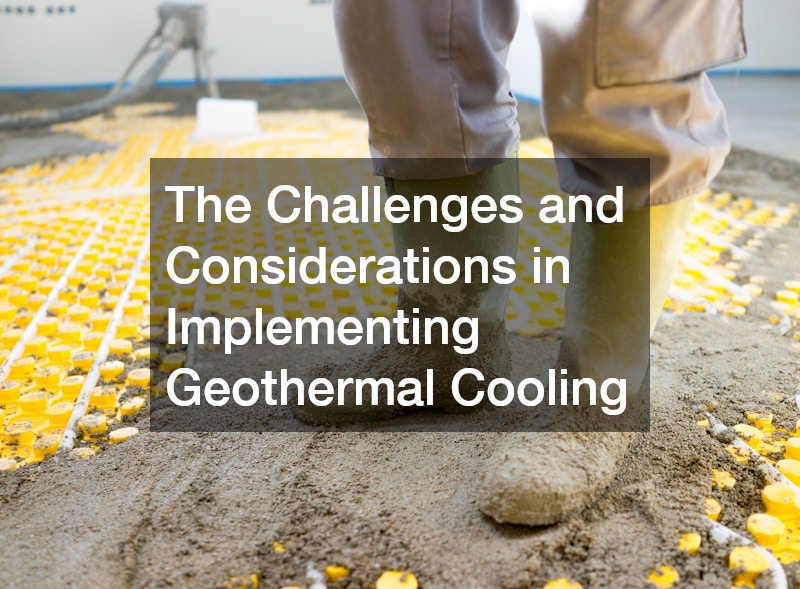How Geothermal Cooling Works and Why Its So Efficient
Geothermal cooling is an innovative and highly efficient method of temperature regulation that utilizes the earth’s natural subterranean temperatures. Its significance is increasingly recognized in the field of energy efficiency, as it provides a means to significantly lower energy consumption and reduce environmental impact. As interest in sustainable practices grows, geothermal cooling is becoming a popular alternative to conventional air conditioning systems, which rely heavily on electrically driven cooling cycles and refrigerants that can harm the environment.
What is Geothermal Cooling and How Does It Work?
Understanding the Geothermal System
A typical geothermal cooling system is composed of several key components that work in harmony to regulate building temperatures. The core component is the ground loop, which is a series of pipes buried in the ground, either horizontally or vertically, depending on the available space and geological composition. This system also includes a heat pump, which transfers heat between the building and the ground loop, as well as distribution mechanisms such as air ducts or underfloor systems that circulate the cooled air throughout the building.
Geothermal systems rely on the fact that below a certain depth, the earth maintains a more consistent temperature than the air above. During the warmer months, the system absorbs heat from the building and transfers it into the cooler ground via the ground loop, effectively reducing indoor temperatures. Conversely, during colder months, the system can reverse the process, extracting warmth from the earth to heat the building.
The Science Behind Heat Exchange
The underlying principle of geothermal cooling is the natural heat exchange that occurs several feet underground, where temperatures remain consistent regardless of surface weather conditions. This phenomenon allows geothermal systems to provide cooling by leveraging the stable thermal properties of the earth, which hover around 50 to 60 degrees Fahrenheit at depths greater than 10 feet. Unlike traditional cooling methods, which become less efficient as outdoor temperatures rise, geothermal cooling maintains its efficiency because the Earth’s core temperature does not fluctuate significantly with seasons.
Heat exchange in geothermal systems is driven by thermodynamic principles. The heat pump plays a crucial role, utilizing a looped cycle of refrigerants that absorb heat when compressed and release it when expanded. This process is finely tuned to transfer heat from the interior of a building to the earth in the summer and vice versa in the winter, effectively balancing indoor temperatures with minimal energy input.
Geothermal Cooling is More Efficient Than Traditional Methods
Energy Efficiency and Environmental Impact
The efficiency of geothermal cooling stems largely from its reliance on the Earth’s stable temperatures, which reduces the need for external energy inputs. Traditional HVAC systems consume significant amounts of electricity to overcome outdoor temperature variations, whereas geothermal systems require much less energy to maintain comfortable indoor climates. This translates into cost savings on utility bills and a smaller carbon footprint, aligning with global sustainability goals and reducing overall greenhouse gas emissions.
Geothermal cooling minimizes environmental impact by utilizing a closed-loop system that prevents refrigerants from entering the atmosphere. This closed-loop feature contrasts sharply with conventional air conditioning units, which often leak refrigerants that are potent greenhouse gases. By reducing reliance on these harmful chemicals and minimizing electrical consumption, geothermal systems offer a green solution that helps mitigate climate change.
Cost-Effectiveness Over Time
While the upfront cost of installing a geothermal system can be higher compared to conventional HVAC units, it’s important to consider the long-term financial benefits and energy savings. Geothermal systems often come with incentives from various government programs aimed at promoting sustainable technologies, which can significantly reduce the initial investment costs. Over time, energy savings accrued through lower utility bills can result in substantial financial benefits, often leading to a full return on investment within five to ten years.
In addition to the energy savings, geothermal systems have lower maintenance costs due to their robust design and fewer mechanical components susceptible to wear and tear. Over a 25 to 50-year lifespan, property owners can experience significant savings, far outweighing the costs associated with the frequent maintenance and replacement of traditional systems. By factoring in these long-term economic advantages, geothermal systems emerge as a financially sound choice for those looking to invest in efficient cooling solutions.
The Challenges and Considerations in Implementing Geothermal Cooling
Implementing a geothermal cooling system requires a thorough assessment of site suitability, an essential step to ensure efficiency and feasibility. Factors such as geology, hydrology, and space availability play a crucial role in determining whether a specific location is appropriate for geothermal installations. Areas with unstable or rocky soil may pose challenges, necessitating alternative installation methods or increased costs to adapt the system accordingly.
Geothermal cooling systems are known for their durability and minimal maintenance requirements, attributes that contribute to their long-term cost advantages. The ground loop components, typically made from high-density polyethylene, are designed to withstand the harsh underground environment and can last up to 50 years or more. The heat pump, situated above ground, generally requires periodic maintenance to ensure optimal performance but has a lifespan exceeding that of conventional HVAC systems, especially with regular servicing.
Geothermal cooling offers numerous advantages, including high energy efficiency, reduced environmental impact, and long-term cost savings. While there are challenges in terms of site suitability and installation logistics, these can be addressed with careful planning and expert guidance. As the world moves toward sustainable energy solutions, geothermal cooling stands out as a promising technology that not only enhances comfort but also supports the global imperative to reduce energy consumption and lower greenhouse gas emissions. Readers considering sustainable improvements to their living or working environments should explore geothermal cooling as a viable and future-proof option.


